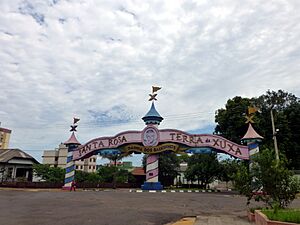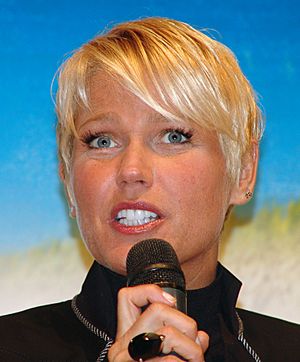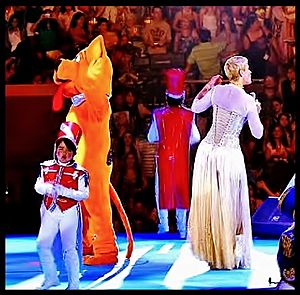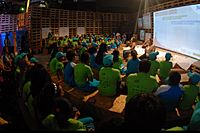Xuxa facts for kids
Quick facts for kids
Xuxa
|
|
|---|---|
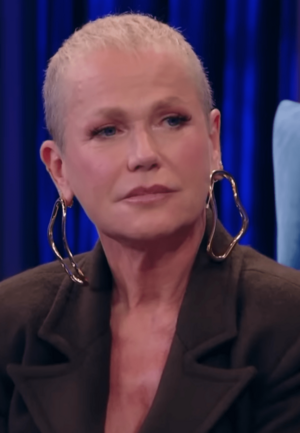
Xuxa in 2024
|
|
| Born |
Maria da Graça Meneghel
27 March 1963 Santa Rosa, Rio Grande do Sul, Brazil
|
| Other names |
|
| Citizenship |
|
| Occupation |
|
| Years active | 1982–present |
| Partner(s) |
|
| Children | Sasha Meneghel |
| Musical career | |
| Genres | |
| Instruments | Vocals |
| Labels |
|
| Signature | |
 |
|
Maria da Graça Xuxa Meneghel (born on March 27, 1963), known simply as Xuxa, is a famous Brazilian TV host, singer, actress, and businesswoman. She is often called "The Queen of Children" because she created a huge entertainment world for kids in Latin and South America.
In the early 1990s, Xuxa hosted TV shows in Brazil, Argentina, Spain, and the United States all at the same time! About 100 million people watched her shows every day. She has sold over 30 million music albums worldwide, making her the best-selling Brazilian female singer. Xuxa is also a very successful businesswoman, with a large net worth.
Contents
Xuxa's Early Life and Education
Xuxa was born Maria da Graça Meneghel in Santa Rosa, Rio Grande do Sul, Brazil. Her family has roots from Italy, Poland, Germany, Switzerland, and Portugal. In 2013, she also became an Italian citizen.
When Xuxa was born, her father promised to name her after the Virgin Mary if she and her mother were safe. That's how she got the name Maria da Graça. Her famous nickname "Xuxa" came from her older brother, Bladimir, when she was a baby. She officially changed her name to Maria da Graça Xuxa Meneghel in 1988.
Xuxa spent her first seven years in Santa Rosa. Then, her family moved to Rio de Janeiro. When she was 15, a modeling agency discovered her. She started her career as a model at 16, working in Brazil and the United States. During this time, she also dated the famous Brazilian soccer player, Pelé. In 1984, she joined Ford Models.
Xuxa's Amazing Career Journey
Starting Out on TV: 1983–1986
Xuxa began her TV career by hosting a children's show called Clube da Criança for Rede Manchete. She would model in New York City during the week and then fly to Brazil on weekends to film her show. In 1986, she got a big offer to host a national children's show for TV Globo, a huge TV company.
Becoming a Star with Xou da Xuxa: 1986–1992
On June 30, 1986, Xou da Xuxa started on TV Globo. This show aired every morning, Monday through Saturday, for about 2,000 episodes until 1992. Xuxa would often enter the stage on a pink spaceship, which made kids dream of flying with her.
She would end the show with her famous "Xuxa kiss." She would put on bright lipstick and kiss the children on their cheeks, leaving a mark. Besides fun, she also shared positive messages like "Want, Power and Reach!" and "Believe in Dreams."
In 1986, her album Xou da Xuxa sold over two million copies, setting a record in South America. Her later albums, Xou da Xuxa 2 and 3, sold even more, becoming the best-selling albums in Brazil. She also went on tours across Brazil, performing for millions of people.
In 1987, a French newspaper listed Xuxa as one of the 10 most important women in the world. Around this time, she also dated Brazilian Formula 1 driver Ayrton Senna. In 1989, she hosted another show for teenagers called Bobeou Dançou.
In 1990, Xuxa's film Lua de Cristal was a huge hit, selling over 4 million tickets. Her movies have been watched by more than 37 million people in Brazil. In 1991, Forbes magazine listed Xuxa as one of the 40 richest celebrities, with earnings of $19 million. She was the first Brazilian to be on this list.
Going Global: 1991–1993
After her success in Brazil, Xuxa released her first Spanish album, Xuxa 1, which did very well in Argentina. She then hosted El Show de Xuxa in Argentina. By 1992, over 20 million Spanish and Portuguese-speaking children watched her show daily in 16 countries, including the United States.
The New York Times called her "Latin American Madonna" because of her huge success. In 1992, the Los Angeles Times said Xuxa was "probably better known to most Latin American pre-adolescents than Michael Jackson."
In 1992, Xuxa also hosted Xuxa Park in Spain, which was a popular game show. Her Xuxa Park album also sold very well. Billboard magazine reported that her album Xuxa 2 was at the top of the Spanish charts. In 1992, People magazine named Xuxa one of the 50 most beautiful people in the world.
In 1993, Xuxa tried to conquer the United States with an English-language show called Xuxa. It was shown on 124 stations, including CBS. However, it didn't become as popular as her shows in other countries and was canceled after one season. She worked very hard, taping 65 episodes in just five weeks. This intense schedule led to her being hospitalized for exhaustion, and she decided to stop her international career.
Weekend Shows and New Projects: 1994–2000
Xuxa returned to Brazilian TV with Xuxa Park, a version of her Spanish show. She had grand entrances, sometimes even coming out of a pyramid or her famous spaceship. This show aired on Saturday mornings until January 2001, when it was suddenly canceled due to a fire during a recording.
She also hosted Xuxa Hits and later Planeta Xuxa, which focused on music performances and had a disco-like feel. Planeta Xuxa was very popular with teenagers and young adults. It ended in 2002 because Xuxa wanted to return to children's TV.
Focusing on Young Children: 2001–2014
As a mother, Xuxa noticed there weren't many videos for very young children. So, in 2001, she created the Só Para Baixinhos (Only for Little Ones) series of CDs and DVDs. The second album, Só Para Baixinhos 2, won a Latin Grammy Award for Best Latin Children's Album in 2002.
Because of this success, Xuxa launched a new educational TV show called Xuxa no Mundo da Imaginação in 2002. It used computer graphics to create a magical world for kids. In 2003, she won another Latin Grammy for Xuxa Só Para Baixinhos 3.
In 2003, Xuxa opened an amusement park called Mundo de Xuxa in São Paulo. It was the largest indoor amusement park in Latin America at the time. The Só Para Baixinhos series continued to be very popular, with albums like Xuxa Circo and Xuxa Festa.
In 2005, her TV show changed to TV Xuxa, aiming for a broader audience. It had different phases, including games, cartoons, and music. In 2009, Xuxa starred in the film Xuxa em O Mistério de Feiurinha, which was watched by over 1.3 million people. She also continued to release new Xuxa Só Para Baixinhos albums, with Baixinhos, Bichinhos e Mais becoming the best-selling DVD in Brazil in 2010.
TV Xuxa moved to Saturday afternoons in 2011 and finally ended in 2014 due to Xuxa's health issues.
New Challenges: 2015–Present
After 29 years with TV Globo, Xuxa signed with Rede Record in 2015. Her arrival at the new TV station was a big event, with many fans and journalists present.
On August 17, 2015, she premiered her new talk show, Xuxa Meneghel, which was inspired by The Ellen DeGeneres Show. It featured humor, music, interviews, and games. This show ran until December 2016.
In 2017, Xuxa started hosting Dancing Brasil, the Brazilian version of Dancing with the Stars. She also launched a new tour of shows called XuChá. In 2019, she debuted The Four Brasil, another reality competition show. In 2023, a documentary about her, "Xuxa, o Documentário", was released on Globoplay.
Xuxa's Music Career Highlights
Xuxa's music career is incredibly successful. Her 1986 album Xou da Xuxa sold over two million copies, setting a record in South America. She released many more albums, including some with songs translated into Spanish.
From 1989 to 1996, Xuxa sold 18 million albums, a record in Latin American music sales. She has recorded about 915 songs and 28 albums, selling over 45 million copies in total. She has received over 400 gold records in Brazil. Her album, Xou da Xuxa 3, sold more than 3.2 million copies, making it the best-selling children's album ever, according to the Guinness Book.
In 2002, Veja magazine called Xuxa the richest artist in Brazil, with an estimated net worth of $250 million. Her earnings were compared to Hollywood stars like Julia Roberts.
Her Xuxa só para Baixinhos music video series has sold over eight million copies. It has also received five nominations and won two Latin Grammy awards for "Best Children's Album."
Xuxa's Social Work
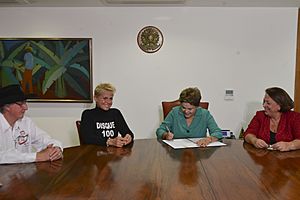
Xuxa is also known for her social activism. In September 2011, she teamed up with Colombian singer Shakira through their foundations. They worked together to help children under six years old in Brazil's poorest communities. They signed an agreement with Brazilian government officials to improve access to education for children in 100 schools.
On June 4, 2014, Xuxa was present when the Senate of Brazil passed a law called Lei da Palmada. This law makes it illegal to use violence in raising children and teenagers.
Xuxa's Personal Life and Business Ventures
Xuxa has one daughter, Sasha, with actor Luciano Szafir, born in 1998. She was in relationships with soccer player Pelé and Formula 1 driver Ayrton Senna. Currently, she is in a relationship with actor and singer Junno Andrade.
At 16, Xuxa started modeling. Her relationship with Pelé helped her become even more famous. In 1982, she was already a well-known public figure, promoting many products. That same year, she started her first company, Xuxa Produções. This company manages the "Xuxa" brand and her image rights. It also helped bring Michael Jackson's Dangerous World Tour to Brazil in 1993.
Xuxa's success grew quickly. By 1987, her salary at Globo TV was already one million dollars a month. She also founded "Beijinho Beijinho Produções" for TV shows and albums. In 1989, she bought a large farm in Rio de Janeiro. This was also when the Xuxa Meneghel Foundation began its important social work.
In 1990, Xuxa founded Xuxa International Corporation to handle her international earnings. She earned $19 million in 1990, making her the first Latin American to appear on Forbes magazine's list of top-earning celebrities. She even bought a mansion in Vargem Grande, Rio de Janeiro, known as Casa Rosa, which became famous in Brazilian pop culture. In 2007, she put it up for sale to give Sasha a more normal life. She also owns an apartment in New York City and a mansion in Miami.
Xuxa continued to expand her businesses, including a modeling course and licensing many products with her brand name. In 1992, her wealth was estimated at US$100 million by People magazine.
After leaving TV Globo in 2015, Xuxa signed with RecordTV for a large monthly salary. Her company, Espaço Laser, which focuses on beauty services, also grew significantly. In 2017, her children's party company, Casa X, saw a 50% increase in earnings. Xuxa is a vegan.
Xuxa's Film and TV Appearances
Television Shows
- Clube da Criança (1983)
- Xou da Xuxa (1986)
- Bobeou Dançou (1989)
- El Show de Xuxa (1991)
- Paradão da Xuxa (1992)
- Xuxa Park (1992)
- Xuxa (1993)
- Xuxa (1993)
- Xuxa Park (1994)
- Xuxa Hits (1995)
- Planeta Xuxa (1997)
- Xuxa no Mundo da Imaginação (2002)
- TV Xuxa (2005)
- Xuxa Meneghel (2015)
- Dancing Brasil (2017)
- The Four Brasil (2019)
Films
- Love Strange Love (1982)
- Fuscão Preto (1983)
- O Trapalhão na Arca de Noé (1983)
- Os Trapalhões e o Mágico de Oróz (1984)
- Os Trapalhões no Reino da Fantasia (1985)
- Super Xuxa contra Baixo Astral (1988)
- A Princesa Xuxa e os Trapalhões (1989)
- Lua de Cristal (1990)
- O Mistério de Robin Hood (1990)
- Gaúcho Negro (1991)
- Xuxa Requebra (1999)
- Xuxa Popstar (2000)
- Xuxa e os Duendes (2001)
- Xuxa e os Duendes 2: No Caminho das Fadas (2002)
- Xuxa Abracadabra (2003)
- Xuxa e o Tesouro da Cidade Perdida (2004)
- Xuxinha e Guto contra os Monstros do Espaço (2005)
- Xuxa Gêmeas (2006)
- Xuxa em Sonho de Menina (2007)
- Xuxa em O Mistério de Feiurinha (2009)
Xuxa's Music Albums
- Xuxa e Seus Amigos (1985)
- Xou da Xuxa (1986)
- Xegundo Xou da Xuxa (1987)
- Xou da Xuxa 3 (1988)
- 4º Xou da Xuxa (1989)
- Xuxa (1989)
- Xuxa 5 (1990)
- Xou da Xuxa Seis (1991)
- Xuxa (1991)
- Xou da Xuxa Sete (1992)
- Xuxa (1992)
- Xuxa (1993)
- Sexto Sentido (1994)
- El Pequeño Mundo (1994)
- Luz no Meu Caminho (1995)
- Tô de Bem com a Vida (1996)
- Xuxa Dance (1996)
- Boas Notícias (1997)
- Só Faltava Você (1998)
- El Mundo Es de los Dos (1999)
- Xuxa 2000 (1999)
- Só Para Baixinhos (2000)
- Só Para Baixinhos 2 (2001)
- Só Para Baixinhos 3 (2002)
- Só Para Baixinhos 4 (2003)
- Circo (2004)
- Solamente para Bajitos (2005)
- Festa (2005)
- Só Para Baixinhos 7 (2007)
- Só Para Baixinhos 8 (2008)
- Natal Mágico (2009)
- Baixinhos, Bichinhos e + (2010)
- Sustentabilidade (2011)
- É Pra Dançar (2013)
- ABC do XSPB (2016)
- Raridades X (2024)
Awards and Nominations
Images for kids
See also
 In Spanish: Xuxa para niños
In Spanish: Xuxa para niños


